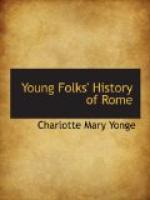There was sure soon to be a terrible struggle. It began between Maxentius and Constantine. This last marched out of Gaul and entered Italy. He had hitherto seemed doubtful between Christianity and paganism, but a wonder was seen in the heavens before his whole army, namely, a bright cross of light in the noon-tide sky with the words plainly to be traced round it, In hoc signo vinces—“In this sign thou shalt conquer.” This sight decided his mind; he proclaimed himself a Christian, and from Milan issued forth an edict promising the Christians his favor and protection. Great victories were gained by him at Turin, Verona, and on the banks of the Tiber, where, at the battle of the Milvian Bridge in 312, Maxentius was defeated, and was drowned in crossing the river. Constantine entered Rome, and was owned by the Senate as Emperor of the West.
CHAPTER XXXVII.
CONSTANTINE THE GREAT.
312-337.
Constantine entered Rome as a Christian, and from his time forward Christianity prevailed. He reigned only over the West at first, but Licinius overthrew Daza, treating him and his family with great barbarity, and then Constantine, becoming alarmed at his power, marched against him, beat him in Thrace, and ten years later made another attack on him. In the battle of Adrianople, Licinius was defeated, and soon after made prisoner and put to death. Thus, in 323, Constantine became the only Emperor.
He was a Christian in faith, though not as yet baptized. He did not destroy heathen temples nor forbid heathen rites, but he did everything to favor the Christians and make Christian laws. Churches were rebuilt and ornamented; Sunday was kept as the day of the Lord, and on it no business might be transacted except the setting free of a slave; soldiers might go to church, and all that had made it difficult and dangerous to confess the faith was taken away. Constantine longed to see his whole empire Christian; but at Rome, heathen ceremonies were so bound up with every action of the state or of a man’s life that it was very hard for the Emperor to avoid them, and he therefore spent as little time as he could there, but was generally at the newer cities of Arles and Trier; and at last he decided on founding a fresh capital, to be a Christian city from the first.
The place he chose was the shore of the Bosphorus, where Asia and Europe are only divided by that narrow channel, and where the old Greek city of Byzantium already stood. From hence he hoped to be able to rule the East and the West. He enlarged the city with splendid buildings, made a palace there for himself, and called it after his own name—Constantinople, or New Rome, neither of which names has it ever lost. He carried many of the ornaments of Old Rome thither, but consecrated them as far as possible, and he surrounded himself with Bishops and clergy. His mother Helena made a pilgrimage to Jerusalem, to visit the spots where our blessed Lord lived and died, and to clear them from profanation. The churches she built over the Holy Sepulchre and the Cave of the nativity at Bethlehem have been kept up even to this day.




